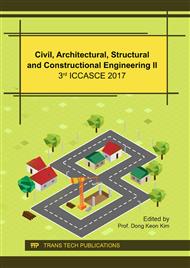p.3
p.8
p.13
p.18
p.23
p.28
p.35
p.41
Experimental and Numerical Analysis of Wood-Framed Buildings
Abstract:
Paper presents current technologies and building structure used in wood-framed multistory buildings and also refers to calculation methods of strains and stresses. Structure of these buildings is recently based on modular technology. Elements in the form of module are constructed in the industrial plant and then delivered to the site for assembling. The wood-framed building structure undergoes significant deformations relevant to changes of moisture content in material and resulted from load acting perpendicular to the grain direction in wood. In four story building the vertical displacement of the top floor has been estimated to over 80 mm. FEM model with application of the shell elements in description of posts, beams and sheathing and applying the beam finite elements in description of linking fasteners is used in stress evaluation in structure. The model permits for precise analysis of stresses in overloaded parts of structure distinguishing to the other simplified analytical models of analyses. Analytical model leads to determination of stresses under typical exploitation standard loadings and in result of non-typical loadings arising at the time of module handling within assembling.
Info:
Periodical:
Pages:
13-17
Citation:
Online since:
February 2018
Authors:
Keywords:
Price:
Сopyright:
© 2018 Trans Tech Publications Ltd. All Rights Reserved
Share:
Citation:


